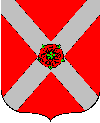 to Bios Page
to Bios Page to
Family Page
to
Family Page to Peerage Page
to Peerage Page to Home Page
to Home PageHenry NEVILLE
(4th B. Abergavenny)
Born: ABT 1530, Abergavenny, Monmouthshire, Wales
Died: 10 Feb 1586/7, Comfort, Birling, Kentshire, England
Buried: 21 Mar 1586/7, Birling, Kent, England
Father: George NEVILLE (3° B. Abergavenny)
Mother: Mary STAFFORD (B. Abergavenny)
Married 1: Frances MANNERS (B. Abergavenny) ABT 1553 /BEF 31 Jan 1555/56, Haddon Hall, Derbyshire, England
Children:
1. Mary NEVILLE (B. Despencer)
Married 2:
Elizabeth DARREL (dau. of Stephen Darrell and Philippa Weldon) ABT 1580, Spelmonden, Kent, EnglandSon of George Neville, 3rd Baron Abergavenny and Lady Mary Stafford, daughter of Edward Stafford, 3rd Duke of Buckingham. Neville had succeeded to the title after his father's death in 1535. The next year his sister Mary married Thomas Fiennes, third B. Dacre of the South.
He held office of Chief Larderer at the coronation of Queen Mary in 1553. He was invested as a Knight of the Bath on 29 Sep 1553. The prominence of Eleanor Paston, Countess of Rutland, at the court of Queen Mary should be influenced, before 1554, to achieve the marriage of her daughter, Lady Frances, with Henry Neville, fourth Baron Abergavenny.
He relied on his wife to obtain a stay of a writ permitting seizure of his lands in Sussex from her brother Henry, 2nd Earl of Rutland.
During the Wyatt’s Rebellion in 1554, Henry and Robert Southwell, the High Sheriff of Kent married to Henry's niece Margaret, led the loyalist forces against the rebels. Sir Robert Southwell and Lord Abergavenny were almost the only significant gentlemen in the country whose loyalty was never in doubt.
Henry and Southwell began recruitment of loyalist forces on 24 Jan, one day before the outbreak of the rebellion, although at this stage they had little success. On 26 Jan Thomas Wyatt declared Henry and Southwell "traitors to God, the Crown and the Commonwealth" for "stirring up the Queen's most loyal subjects of the realm". By 27 Jan the loyalists's position improved, and their combined forces in Kent matched the numbers of Wyatt's force in Rochester, at around two thousand men on each side. Henry and Southwell with six hundred men blocked the road from Tonbridge to Rochester to prevent consolidation of the rebels. On 28 Jan Southwell defeated Henry Isley's company of rebels at Wrotham, taking around sixty prisoners. However, on the same day the army of Duke of Norfolk deserted to Wyatt; Henry and Southwell fled to London. Wyatt marched to London himself with around three thousand men, but lost the initiative; Southwell and Thomas Cheney managed to raise another loyalist company in his rear. On 4 Feb Henry and Southwell marched to Greenwich. Wyatt was cut off from his base in Kent, and could not count on reinforcements while the loyalists' forces gained strength every day. By 7 Feb Wyatt's army disintegrated. Amongst Wyatt's supporters who were later sentenced to death was Thomas Fane, later Henry Neville's son in law. Fane was pardoned due to his youth and he went on to become a loyal supporter of the crown, member of parliament and son in law to Neville.
When her husband William Brooke was arrested and condemned for his part in Wyatt’s Rebellion, his sister Dorothy asked, Henry, Lord Abergavenny, to interced to secure Brooke’s release.
Henry, fourth Lord Abergavenny, had summons to parliament on 23 Jan 1552, to 15 Oct 1586. On 6 Oct 1586 at Fotheringhay, Northamptonshire, England, he was one of peers who tried Mary, Queen of Scots.
Lord Abergavenny was accused of behaving in a riotous and unclean manner by some Puritain commentators.
By his first wife, he had an only daughter Mary Neville who married Sir Thomas Fane. (w. of Elizabeth Culpepper, who died in child-birth). When Frances died in 1576, Neville remarried to Elizabeth Darrell, daughter of Stephen Darell, of Spelmonden, Kent (she remarried to Sir William Sedley, of Southfleet, Kent, Knt. and Bart.). They had no issue. He died 10 Feb 1586/7 at his seat called Comfort, near Birling, Kent, without male issue.
Sources:
Froude, J. A. (1889). The Reign of Mary Tudor. 2008 reprint: Bibliobazaar LLC, ISBN 1-4346-9230-2.
Harris, Barbara J. :
English Aristocratic Women, 1450-1550 (2002) Oxford University Press
Loades, D. M. (1965). The Two Tudor Conspiracies.
Cambridge University Press.
 to Bios Page
to Bios Page |
 to
Family Page to
Family Page |
 to Peerage Page
to Peerage Page |
 to Home Page
to Home Page |